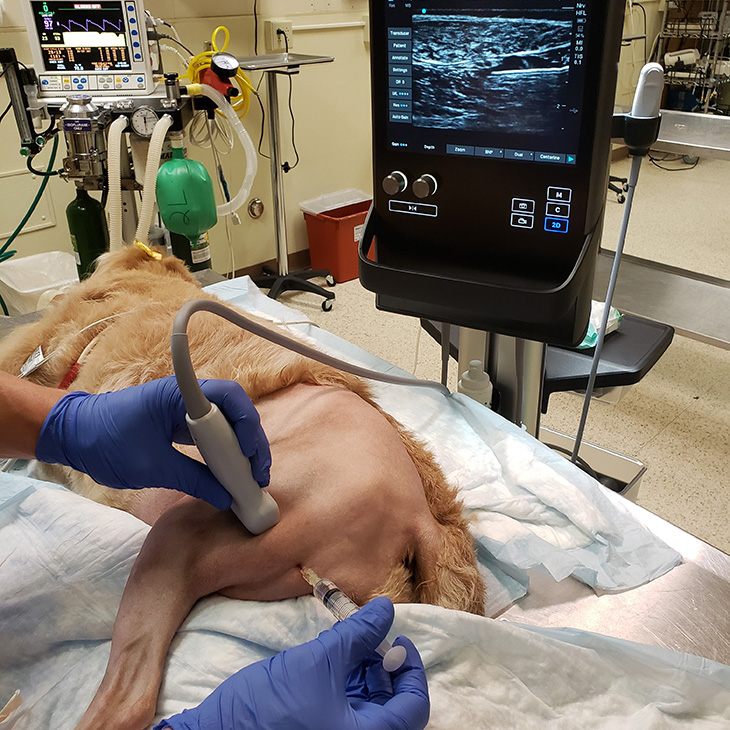
When Your Pet Needs Anesthesia
Monday, July 6, 2020
Tens of thousands of pets undergo general anesthesia every year in the United States. It may be scary to think of your pet under anesthesia, but it’s generally very safe: Recent studies show only 0.17 percent of dogs and 0.24 percent of cats die as a consequence of anesthesia.
Once the veterinarian schedules a pet’s surgery, the owner receives detailed instructions on preparing for general anesthesia, which includes withdrawing food and handling any ongoing treatments.
General anesthesia is never a risk-free experience; however, significant advances in anesthetic and analgesic drugs and techniques have drastically reduced the incidence of domestic animals dying during surgical procedures. Age, body weight and general health condition are among the most important criteria veterinarians use to assess a pet’s anesthetic risk. A perfectly healthy young dog anesthetized for a spay or a neuter is extremely unlikely to encounter serious anesthetic complication, while the situation may be different for a geriatric cat requiring extended anesthesia time for multiple tooth extractions or a morbidly obese dog requiring even minor surgery for a skin laceration or a superficial mass removal.
Pets can exhibit a wide range of reactions in a veterinary hospital. Some animals maintain a friendly social behavior and do not seem affected while others appear intimidated, fearful and anxious. Fortunately, a variety of sedative and tranquillizer drugs are available to help settle them settle. Some of these drugs may be prescribed for at-home administration the day before a pet is scheduled for anesthesia and surgery.
Interestingly, the veterinary community has learned a lot from their human medical counterparts in terms of the discomfort experienced by patients undergoing anesthesia. For example, many people report suffering from post-operative nausea and vomiting. While it may be difficult to know that our pets experience nausea, it is plausible to assume so. Many veterinarians often use antiemetic and antacid medications to reduce this.
The management of pain during surgery is probably the aspect of veterinary medicine that has undergone the most significant development over the past decades and once again, veterinarians have learned much from human doctors. It is now scientifically demonstrated and universally accepted that all animals feel pain, and all try to avoid it. Therefore, many veterinarians apply the so-called multimodal analgesic approach prior to and during surgery, administering a combination of several drugs, each of which abolishes pain by a different mechanism. The combination allows veterinarians to use a much lower dose of each drug, significantly reducing the side effects with more complete pain control.
Some large veterinary hospitals have a team of doctors and technicians who underwent advanced specialty training in anesthesiology and pain management.
Specialized veterinary anesthesiologists can use local anesthetic drugs by targeting selected nerves that provide sensation to the area that requires surgery. For example, if a dog undergoes anesthesia for knee surgery, blocking only the sciatic and femoral nerves completely abolishes the pain sensation in the knee. This technique is called ultrasound-guided peripheral nerve block, because echography is used to precisely locate the nerves and verify the correct position of the needle that will inject the desired amount of local anesthetic.
Every animal is strictly monitored during anesthesia. Vital parameters including heart rate, blood pressure respiration rate and body temperature are recorded every five minutes. This frequent monitoring and recording allows veterinarians and technicians to detect the slightest change in status and promptly intervene to correct any abnormalities.
When surgery ends, the pet is assisted through the recovery process. Sometimes regaining consciousness is a very smooth transition; other times, animals may appear confused and agitated, exactly like people undergoing a similar experience. Once again, dedicated veterinary personnel know how to care for a pet during this delicate phase and can judge when the administration of tranquillizers or additional analgesia is indicated.
Once recovery is complete, the animal is usually left undisturbed to sleep and relax because the body needs time to recuperate energy and recover from the stress of surgery and anesthesia. However, even during the post-operative phase, pets are never left unattended and monitoring of vital parameters and periodic re-assessment of adequacy of analgesia continues for several hours in the intensive care unit. Pets are allowed to return home only after the veterinary team establishes that they have fully regained consciousness and appetite, and their vital parameters are all back to normal values. Analgesic drugs are frequently prescribed for use at home until a postoperative recheck.
OSU’s Veterinary Medical Hospital employs two veterinarians board-certified in anesthesia and analgesia as well as four veterinary technicians with advanced training or specialty certification in anesthesia.
STORY BY: Stefano Di Concetto, DVM, MSc, DACVAA, an associate professor in the Department of Veterinary Clinical Sciences at the Oklahoma State University College of Veterinary Medicine’s Veterinary Medical Teaching Hospital. He is board certified in anesthesia and analgesia.
